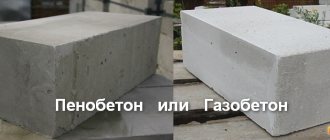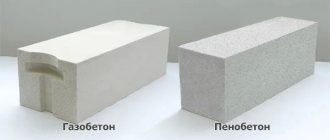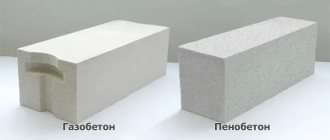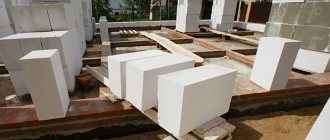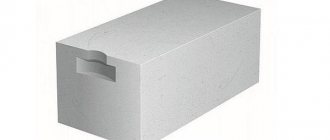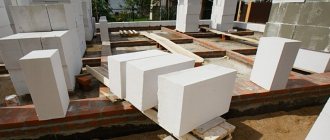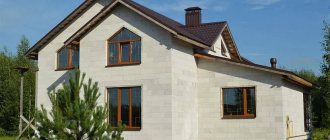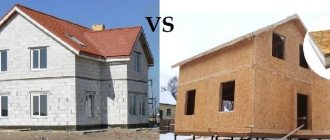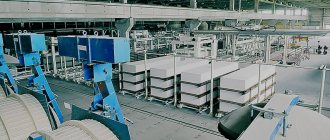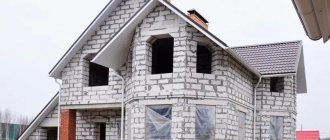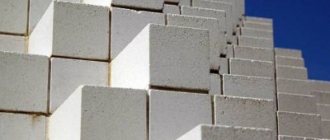In the cellular concrete segment, two popular materials compete – foam concrete and aerated concrete. When planning the construction of a house, cottage, garage or bathhouse, each owner tries to take into account all the nuances, predict various situations, estimate the cost, in general, create the most realistic plan before starting work.
The first and important task is the choice of material for load-bearing walls. What is better to build a house from, foam block or gas block? Each of them has its own positive and negative reviews.
Foam concrete or aerated concrete – which is better for building a house?
Cellular concrete is a group of building materials made from concrete and various additives that give it a porous structure. The most famous representatives of this type are aerated concrete and foam concrete.
At first glance, these are identical materials. However, there are also differences that form distinctive properties, which are the stumbling block between supporters and opponents of these materials.
To make an objective conclusion and make the right choice, we suggest that you familiarize yourself with the difference between a gas block and a foam block - a comparison of characteristics, properties and price. To do this, we will study all stages of the life cycle of these wall materials, starting from the technological production process, ending with decorative finishing, i.e. Let's conduct a full comparative analysis.
We recommend material on the topic:
Pros and cons of aerated concrete houses + reviews from owners
Pros and cons of foam concrete houses + reviews from owners
and
Advantages and disadvantages of foam concrete blocks + which one to choose
Comparison of which is better: foam blocks or gas blocks
Production of aerated concrete blocks
The production of aerated concrete is carried out in a special container, where the material, under the influence of pressure, water vapor and temperature, acquires the strength necessary for operation. To prepare the mixture, use the following ingredients:
- Portland cement grade M400 or M500 (binder) with a volume of 35-49%;
- limestone volume 12-26%;
- quartz sand (filler) 31-42%;
- aluminum powder, which is a pore former – up to 0.1%;
- calcium chloride – 0.18-0.25%;
- calcium silicate – 2.6%;
- process water of medium hardness at a temperature of 40-60 °C until the full volume is 100%.
The concentration of ingredients is determined experimentally and may vary. Additives that improve the strength of the mixture are introduced depending on the required strength of the massif and where the material will be used.
Main stages of production:
- First, pre-dosed components (sand, cement, lime) are mixed.
- Water and aluminum powder are added to the mixture.
- The composition is poured into special forms in which it settles until the chemical reaction is completed.
When interacting, a gas is released that forms cells. The volume of material increases. At this stage, the strength is not yet final. Hardening occurs naturally, which makes it possible to produce foam concrete blocks directly on the construction site - The not completely thickened mass is cut into elements using special equipment.
- Excess mixture remaining after cutting is removed. They are reusable.
- Steaming is carried out in a hermetic container under a pressure of 11 atmospheres and a temperature of 180⁰ C. Aerated concrete blocks acquire their final strength characteristics under the influence of processes occurring during steaming. Aerated concrete acquires a crystalline structure and operational strength.
- Products are stored on wooden pallets.
- The material is hermetically protected by polyethylene from moisture.
Features of the technological process make it possible to produce aerated concrete blocks only in production conditions, where special equipment is available, quality is controlled, and control of steaming modes is automated.
Production of foam concrete and aerated concrete
Comparison within the framework of manufacturing technology (production)
Compound
Both materials are produced by mixing concrete with materials that give it a porous structure.
But, in the production of foam concrete, such a material (foaming agent, plasticizer) is wood saponified resin (WRS), and aerated concrete is pulverized aluminum.
Manufacturing technology
Foam concrete is produced in the form of separate blocks. In this regard, the variety of its sizes and types is limited.
Aerated concrete is produced in a mass, which, after hardening, is cut into blocks of a given size and configuration. Thus, a greater geometric diversity of elements in size is achieved.
Production
Aerated concrete blocks are produced only in factory conditions using specialized equipment.
Foam concrete can also be produced in small enterprises (mini-factories, installations, artisanal, private production).
Pores (cells)
Due to the nature of production, the pores on the outer surface of the aerated concrete block remain open, which makes it look like a sponge. During a day in water, aerated concrete gains up to 47% moisture. Those. becomes almost twice as heavy. the material is unprotected from moisture or precipitation. If you add frost to this, then an unprotected aerated concrete wall will quickly become covered with a network of small cracks, which can be eliminated in various ways.
The pores of the foam concrete block are closed throughout the mass. This gives it hydrophobic properties. Foam concrete is like a float - it will float on the water for a long time.
As user tests show, foam concrete that has stood (gained strength) for a month (recommended time) is able to stay on the surface of the water for more than a month.
Visual differences
If you compare the structure of the blocks with the naked eye, then pay attention to the larger pores of the foam concrete. The following differences in color and structure of materials are clearly visible:
- a smooth surface with a gray tint is characteristic of foam blocks;
- gas silicate has a textured, rough surface and is white in color.
You can conduct an experiment yourself. To do this, break off a small piece from the gas silicate or foam block and place it in a container of water. The first one, which has open pores, will quickly sink after absorbing moisture. Foam concrete will float on the surface for some time, as it weakly absorbs moisture. Thus, we figured out which material is more moisture resistant.
Characteristics of foam concrete and aerated concrete
Side-by-side comparison within material properties and characteristics
Pore sizes
Aluminum powder or paste, distributed over the aerated concrete mixture, allows you to obtain bubbles of the same size - pores.
In foam concrete, the pores are different in type (volume). Material prepared for the website www.moydomik.net
Density
The same for foam concrete and aerated concrete, it ranges from 300 to 1200 kg/m3 and depends on the brand. For example, brand D 500 has a density of 500 kg/m3 at the natural moisture content of the material;
Weight (whichever is heavier)
The weight of cellular concrete also depends on the brand. For example, 1 cubic meter. material grade D 500 will weigh 500 kg.
Strength (which is stronger, stronger)
For aerated concrete, it is uniform throughout the entire volume of the block, while for foam concrete it is non-uniform, which is due to the specific distribution of the foaming additive.
In addition, foam concrete and aerated concrete have low bending strength. This puts forward additional requirements for the construction of the foundation and its ability to ensure the dimensional stability of the house (prevent uneven shrinkage).
Strength gain
Aerated concrete has a maximum density (corresponds to the brand) in the early stages of production. During storage of gas blocks or operation of the building, it decreases.
Foam concrete, on the other hand, needs at least 28 days from the date of production in order to reach the declared density. This puts forward special conditions for the start of construction work.
To make sure that the block has gained strength, it is better to purchase it in advance and store it at the construction site for a month. Otherwise, a structure built from freshly made foam concrete will experience significant shrinkage. It is worth noting that foam concrete gains strength with use. That is, the older the block or house made of foam concrete, the stronger it is.
Size (geometry)
Due to the fact that aerated concrete is cut and not poured into formwork, its dimensions are much more accurate. This helps to achieve a smaller thickness of the masonry seam (2-3 mm) and reduce the area through which heat escapes to the outside (cold bridges).
The thickness of the foam block seam varies widely and is 2-5 mm. To a large extent, the thickness of the seam is determined by the skill of the masonry worker.
Moisture absorption
The ability to absorb water is greater in aerated concrete, which is due to the presence of open pores.
Thermal conductivity (which is warmer)
With the same density (brand of block), foam concrete and aerated concrete retain heat differently.
Aerated concrete is a better heat insulator than foam concrete. For example, a sufficient wall thickness for Moscow and the Moscow region when using D 500 foam block will be 600 mm, when using aerated concrete, only 450 mm.
conclusions
Since there is no ideal building material, the final choice between gas silicate or foam concrete blocks will depend on many factors: the purpose of the structure, the number of storeys, the expected service life (planned durability), the possibility of arranging a sufficiently powerful foundation, economic feasibility and the possibility of purchasing products from a proven manufacturer. manufacturer market. By purchasing high-quality blocks and following construction technology from a specific material, you can erect a reliable building that meets your requirements, both from foam concrete and gas silicate.
Laying foam concrete and aerated concrete
Comparison of differences within the construction process (installation, laying, processing)
Foundation requirements
They are identical, since both types of cellular concrete are lightweight. However, an unprotected aerated concrete block, after getting wet, becomes almost half heavier, which creates additional pressure on the foundation. Foam concrete does not have this feature.
Cutting, sawing, drilling blocks and additional elements
They are identical; thanks to their structure and composition, cellular concrete blocks can be given the desired shape using a regular hand saw. Drilling, punching a hole or groove (groove) is also easy.
Speed of construction (laying, installation)
The low weight of both materials being compared makes the construction process quick and simple, compared, for example, with piece bricks.
Requirements for mortar and adhesive for installation
For aerated concrete, you need to use a special adhesive mixture, this allows you to reduce consumption and ensure a thin seam.
Foam concrete can be laid on glue or sand-cement mixture.
Protection (preservation)
If there is a need to suspend or stop construction work, for example, in the winter, the materials need to be preserved. At the same time, walls made of foam blocks will last for a certain period without problems, but walls made of aerated blocks need to be wrapped in film so that they do not absorb moisture. Moreover, aerated concrete needs protection at any time of the year. Of course, in the summer this is not so critical, a wall made of aerated concrete will dry out in a week or two (is it worth interrupting work for so long?), but in the winter this getting wet followed by freezing and thawing can lead to destruction;
Shrinkage
Foam concrete can shrink within 1-3 mm/m.m., shrinkage of aerated concrete does not exceed 0.5 mm/m.m.
Ability to hold fasteners
For both materials, you need to use special fasteners (hardware, screws, chemical anchors). They are designed specifically to be fixed in walls made of blocks with a porous structure.
Scope of application
When constructing a low-rise building, foam concrete is used. It is used in construction:
- internal partitions;
- capital walls;
- various types of enclosing structures.
Taking into account the characteristics of the materials, foam blocks can be used to construct load-bearing walls of buildings with no more than 3 floors.
Foam concrete is an environmentally friendly material
Gas silicate is widely used in construction. It is suitable for the following purposes:
- Construction of building partitions.
- Construction of capital walls.
- Formation of monolithic structures.
- Construction of buildings with increased number of storeys, subject to the use of reinforcement belts.
Finishing of foam concrete and aerated concrete
Comparative analysis within finishing materials and works
Finishing material
For cladding aerated concrete and foam concrete walls (facade), you can use: siding, lining, plaster, ventilated facade.
Insulation material
Due to the fact that the pores of foam blocks and gas blocks contain air, they are good heat insulators. Therefore, a house made of aerated concrete or foam concrete does not need insulation (if the walls are sufficiently thick). If such a need arises or, for example, a bathhouse is built from these materials, only flexible insulation should be used.
Plaster mixture
For foam concrete and aerated concrete, you need to use special mixtures. The main advantage of plaster for cellular concrete is that it retains the ability to breathe. At the same time, the requirements for plaster for foam concrete also consist in the fact that the composition must have good adhesion to the surface.
Plastering technology
The more porous structure of aerated concrete gives it greater adhesion to any plaster.
Foam concrete requires the use of a reinforcing mesh in order for the plaster to hold securely. As an alternative, craftsmen advise treating the surface of the foam block with a float or sandpaper.
Main results
Foam concrete and gas silicate are types of cellular concrete. Both materials have a number of positive characteristics, but there are also weaknesses.
Some of their indicators are extremely similar, but their different characteristics make you think about the practicality of using one of the materials. Water absorption is the main disadvantage of products made from these types of concrete, but with technically correct finishing, negative consequences can be avoided.
The production process, with automated equipment, is quite simple. However, if you want to make blocks with your own hands, then you should prepare for a serious investment of time and effort.
If you are faced with a question: which is better, foam concrete or gas silicate blocks? First of all, you should decide which indicators are most important for you when building a house. In this case, the answer will be much easier to find.
Cost of foam concrete and aerated concrete (which is cheaper)
Foam concrete is 20% cheaper than aerated concrete of the same brand. It is cheaper because... Cheaper materials and equipment are used in its production. This also leads to the appearance of a large amount of falsified material.
However, when calculating the cost of construction, you should not take into account only the purchase price of the blocks. It is also necessary to take into account the price and consumption of the adhesive mixture, finishing materials, the need for additional materials (rebar, reinforcing mesh, additional insulation, water repellents, etc.). Only after this can we say with confidence whether aerated concrete or foam concrete is cheaper.
Strength parameters
What is stronger: foam concrete or gas silicate? The strength indicator is affected by density. Foam concrete products have a density from 650 to 700 kg/m³. Gas silicate has a lower density - 450 kg/m³. It seems that foam concrete should have greater strength. But the manufacturing process and production features make it possible to use silicate blocks under the same loads that foam concrete absorbs.
Gas silicate has a large margin of safety. The material is of higher quality and durable. This must be taken into account when planning construction. When using it, the customer's costs will increase.
Comparison of foam concrete and aerated concrete - which is better (table)
The table compares the main parameters that determine the properties of gas blocks and foam blocks. As a result, it is possible to determine which material to choose for construction under given conditions and requirements.
| Parameter | Foam concrete | Aerated concrete |
| Pore-forming additive | wood saponified resin (classified as moderately hazardous substances) | pulverized aluminum |
| Manufacturing technology | Block casting | Block cutting |
| Variety of elements | Less | More |
| Manufacturing | Handicraft production possible | In factory conditions |
| Pores | Closed | External - open, internal, mostly closed |
| Pore sizes | different sizes | same size |
| Block sizes | ||
| height (thickness) | 200, 300, 400 | 200 |
| length | 600 | 500, 600 |
| width | 100-300 | 75-500 |
| Density, kg/m3 | 300-1200 | |
| Weight, kg/m3 | 300-1200 | |
| Compressive strength, for grade D500 | IN 1 | B 2.5 |
| Strength gain | Does not correspond to the calculated one, with further recruitment | Instant with further loss |
| Size Accuracy | Objectively existing errors | Minimum error |
| Moisture absorption | Less | More |
| Frost resistance, cycles | F-30 | F-25 |
| Thermal conductivity, W/M*k | 0.08 (thermal insulation) – 0.36 (structural) | 0.1 (thermal insulation) - 0.14 (structural |
| Appearance | Worse | Better |
| Foundation requirements | identical | |
| Easy to install, cut, drill | identical | |
| Requirements for the adhesive mixture | Any | Only special mixture |
| Wall protection | Need not | Need |
| Shrinkage, mm/m.p. | 2-3 | 0,5 |
| Ability to hold hardware | identical | |
| Finishing material | Any | Allowing you to maintain the ability of the block to “breathe” |
| Insulation material | Preferably soft insulation (if necessary) | |
| Plastering | More difficult due to the smooth structure of the block | Simple |
| Price, rub/m3 | 2200-2800 | 3200-3500 |
Bottom line
As you can see, there is no clear answer to the question of which is better, aerated concrete or foam concrete. Based on this table, we can conclude that foam concrete and aerated concrete have significant differences that do not allow them to be put on the same level. Despite this, the general conclusion will be: aerated concrete has the best strength indicators, foam concrete in all other respects. Which criterion is more important depends on the specific situation, region and construction budget. Accordingly, everyone decides for themselves whether to build a house from foam blocks or gas blocks.
Rules for choosing when purchasing
It is necessary to select blocks with clear dimensions, without chips, and uniform color.
The grade and density of the material are determined by the purpose of use (thermal insulation, partitions or loaded walls).
Pay attention to the quality of the stones:
- uniform color indicates a conscientious manufacturer;
- What matters is the evenness of the surface and adherence to geometry - such products will save glue or mortar when laying;
- the absence of chips, cracks, and swelling indicates compliance with the technology.
The supplier must provide a quality certificate . Factories pack products in film and put them on pallets to reduce the risk of destruction during transportation. Each pallet is marked with parameters. If the blocks are sold in bulk, the risk of buying handicrafts increases.
Ecological cleanliness
Aluminum powder used in the manufacture of gas-filled products has a negative effect on people. During production, 0.4 kg of aluminum powder is added to 1 cubic meter of the mixture. However, during manufacturing, a chemical reaction occurs, which results in the gas generation of aluminum oxide and the formation of air cells. They double the volume of the array. There is no metallic aluminum in the finished gas-filled composite. This ensures its harmlessness to others and environmental friendliness. Foam blocks are made from environmentally friendly raw materials and do not have a negative impact on the health of others.
Features of use
Both materials are used for the construction of new buildings, both private and industrial.
Application of foam concrete
Using the property of this material to resist moisture, it is often installed at cold-heat junctions and in places where there is high moisture. Foam concrete building blocks are used for laying load-bearing walls, partitions, and partitions. They are used to build houses, cottages, garages, dachas and various outbuildings, the height of which does not exceed two floors.
You can learn about the pros and cons of gas silicate blocks, as well as find out the opinion of experts from this article.
The video shows the use of foam concrete:
You can learn about the pros and cons of baths made of expanded clay concrete blocks, as well as the differences with foam blocks, from this article.
They are also often used for flooring in private houses and apartments. For greater comfort, foam concrete of different densities is used, and a layer of thermal insulation is laid between them. They are also used for finishing buildings that were built from bricks.
The unique characteristics of aerated concrete blocks have created a wall material with a porosity of up to 85%. It has the hardness of stone and the porosity of wood.
Differences between products
| Characteristic | Foam block | Gas block |
| Color | Grey | White |
| Surface | Smooth | Rough |
| Brand by density | 700, 800, 900 | 350, 400, 500, 600, 700 |
| Strength indicators | Class B2.0 at D800 | Class B2.0 at D500 |
| Lifetime | 70 years old | 50 years |
| Vapor permeability | Low | High |
| Thermal conductivity | High | Low |
| Laying technology | It is carried out using a masonry mixture with a seam thickness of 10 mm, so cold bridges are formed. | The blocks are connected using glue, the seam thickness is 1 mm, so there are no cold bridges. |
| Geometric parameters | The material is produced in molds and the deviations are 5 mm. | The product is cut using innovative equipment, so deviations of no more than 1 mm are possible. |
| Shrinkage | 3 mm/m | 0.1 mm/m |
| Base load | High | Low |
| Convenience of masonry | Difficult due to the large mass | Easier, because the product is lightweight |
| Soundproofing | — | + |
| Ease of handling | Difficult | Simple, since the material has low density |
| Eco-Friendly Factor | 4 | 2 |
| Moisture resistance | + | — |
| Frost resistance | — | + |
| Fire resistance | + | + |
| Price | Below | Higher |
